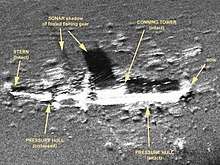Target strength

Sonar image of the wreck of USS O-9.
The target strength or acoustic size is a measure of the area of a sonar target. This is usually quantified as a number of decibels. For fish such as salmon, the target size varies with the length of the fish and a 5 cm fish could have a target strength of about -50 dB.[1]
Target strength (TS) is equal to 10 log10(σbs), where σbs is the differential backscattering cross section. Backscattering cross section is 4πσbs.
References
- ↑ J.E. Ehrenberg (1989), "A review of target estimation techniques", Underwater Acoustic Data Processing, Springer
Further reading
- "Introduction to the use of sonar systems for estimating fish biomass, FAO Fisheries Technical Paper No. 191, Revision 1, FAO 1982"
- Fisheries Acoustics Simmonds, E John and MacLennan, David N (2005) Blackwell Publishing. ISBN 978-0-632-05994-2
- C. S. Clay & H. Medwin, Acoustical Oceanography (Wiley, New York, 1977)
target strength formula:
TS=10log((R^2)/4) FOR Circular
TS=10log((RL^2)/(2*landa)*(SIN(B)/B)^2*COS(U)^2) B=KL*SIN(U) K=2pi/landa
This article is issued from
Wikipedia.
The text is licensed under Creative Commons - Attribution - Sharealike.
Additional terms may apply for the media files.